New faces, funds needed at Prospect shoreline in Madison Park
By Jessica Keller Madison Park Times editor
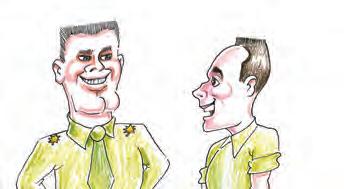
When community and public shoreline advocate Gene Brandzel spearheaded the effort to turn the weed- and trash-ridden land on 41st Avenue East and Prospect Street into a nature preserve, he had hoped to create a legacy for area residents to enjoy.
Now, interim steward Octavia Chambliss is hoping new faces and funds will help secure the Prospect Nature Preserve’s future in Madison Park.
Chambliss, a now-retired landscape designer who worked with Brandzel on the Prospect Steet shoreline efforts, said the 11,000-square-foot preserve is not thriving as it should.
The last two exceptionally hot and dry summers have been hard on the preserve and prevented the park’s plants from getting established, Chambliss said. As a result, plants have died, and invasive species like wild clematis, horsetail and morning glory have moved in.
“What we really need are more work parties to get the preserve established because there are so many invasive plants,” Chambliss said.
Until the plants becomes established, Chambliss anticipates double the work will be needed in the next year or so to ensure the preserve thrives.
“What would be ideal is if we could have a mix of work parties and raise enough funds to hire a work crew to come out once or twice a year to help with weeding, pruning, mulching,” Chambliss said.

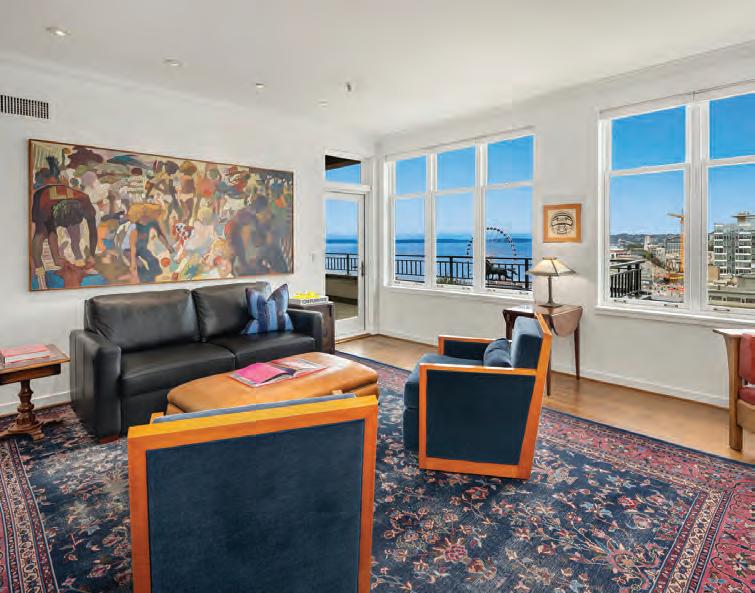



But that means additional help and funding is needed, as well.
Turning the over-run street end into a public shoreline was a passion for Brandzel, and Chambliss said the preserve would not have been possible without him finding volunteers for work parties, raising money and working with the Seattle Department of Transportation Shoreline Street Ends project manager. Chambliss does not want his efforts to be in vain.
“It’s a real gift to the neighborhood,” Chambliss said. “It’s a real legacy for the neighborhood.”
Since Brandzel died last year, Chambliss has assumed an interim steward role and organized several volunteer work parties this year to tame the park and care for the
SEE PRESERVE, PAGE 7
The Prospect Nature Preserve in Madison Park next to the tennis club has not thrived as it should since it was spearheaded by former resident and street end advocate Gene Brandzel, who passed away in 2021. Interim steward
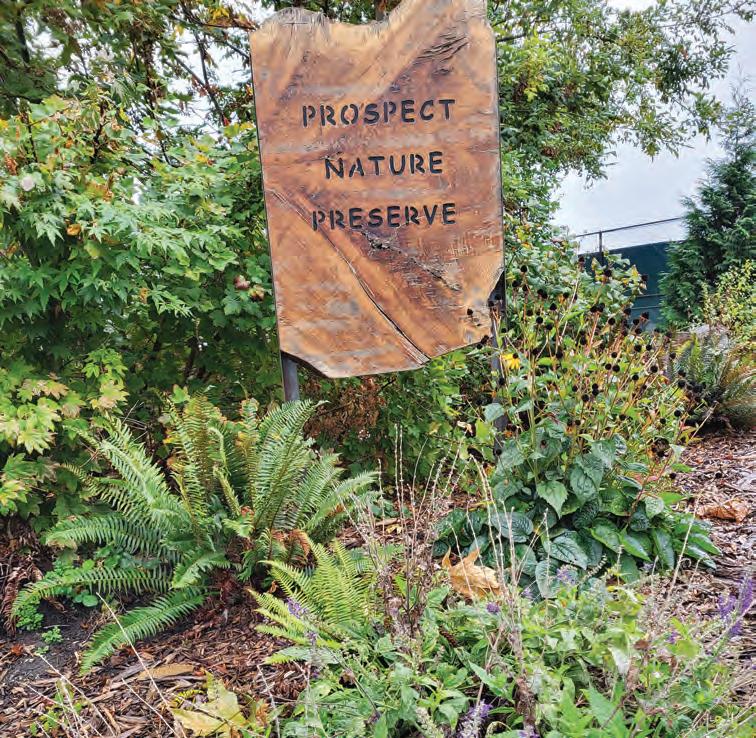
Chambliss is hoping to generate new interest in

ensure it thrives.
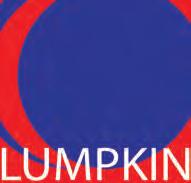
Page 4 REAL ESTATE Page 6 Featured Stories Winter Blues Property Views Revisiting the Park PRSRT STD U.S. POSTAGE PAID SEATTLE, WA PERMIT 1271 4 beds/3 baths MADRONA VIEW HOME Each office is independently owned and operated. TOBY LUMPKIN 206.786.2035 Toby.Lumpkin@RSIR.com New listings needed. Call for a confidential consultation. "Toby, thank you so much for your extra awesome care with my mom and getting it done. You went beyond the extra mile in terms of holding her hand." EXPERIENCE MATTERS What my clients are saying A VIEW JEWEL BOX, WATERFRONT PLACE! SPAFFORD ROBBINS 206.963.7770 | SPAFFORDROBBINS.COM Madison Park Times www .M adison P ark T i M es co M facebook.com/MadisonParkTimes @MadisonParkTime NOVEMBER 2022 Serving East-Central Seattle since 1983
Photo by Jessica Keller
the shoreline and
money to
Preserving the preserve
Octavia
raise
On a warm evening in early September, a friend came over to watch a movie. What we really wanted was to indulge in the popcorn I would drench in enough butter to make a luscious breather from real life. It is so good to get a breather from real life.
She and I have been friends for ages — despite a few bumps in the road during the Trump administration. So, when she suggested that I stop resisting and finally watch the KOMO News Documentary “Seattle is Dying,” I couldn’t decide whether to object or pour myself a tumbler of gin and give in.
I know. You saw it ages ago. Everyone saw it ages ago. But me? I didn’t want to watch it. I got fretful just thinking about watching it. When it first came out in 2019, I was living in my own little dying neighborhood, already fearful about walking anywhere at night. By 2021, even in daylight, so much about Belltown was dangerously scary. So, when she first suggested we watch the documentary back in the summer of 2020,
BRIEFLY
Fundraisers established to benefit family of slain Seattle business owner
Two GoFundMe campaigns have been set up to benefit the family of D’Vonne Pickett Jr., who died after being shot outside his Central District business, The Postman, Oct. 19. The fundraisers will help support D’Vonne’s wife, KeAnna, and the couple’s three children. People can donate at https:// gofund.me/3fd72151 or https:// gofund.me/e75098c0/.
Wine tasting to benefit food pantry
Madrona Neighborhood Association, in collaboration with Epiphany Parish, is hosting a wine-tasting fundraiser to benefit the People’s Pop-Up Pantry,
I suggested that we reschedule to a day when I hadn’t seen anyone shooting up in my building’s entry stairwell. She wanted to watch it anyway. I suggested an episode of “Call the Midwife.” But to have a friend, we must be one. So, well, fine, I agreed to watch. And I thought I’d react to the documentary in the same way I’ve come to view cable news — that we are not being told the truth; that singing to our own choir is not trustworthy reporting, it is mostly for entertainment purposes, and it is divisive.
The thing was, I was riveted.
Generally, I back away even from the words “right” and “left,” let alone the idea of edging my way closer to the side of KOMO on the issues of homelessness and addiction. Yet, that edging felt more like barreling as the documentary continued.
My first thought was that I was relieved I’d left Belltown. Right up until the day we moved, I thought I was doing a pretty good
job of coping because the thought of upheaving my whole life makes me a little crazy. But lately I’m trying to give more thought to accepting exactly how things are and moving on if something or someone causes me pain, forgiving the perpetrator, as well as myself, along the way. I am even trying to forgive Seattle’s City Council for — well, you know — all of it. I might be holding on to a little grudge, however. It’s so hard to forgive stubborn incompetence, and too many of our council members are appallingly lacking in leadership skills. But I’m not going to give up on Seattle. I didn’t give up on New York in the early ’90s or after 9/11. And today, I feel safer when I return to Manhattan than I do on the downtown streets of Seattle.
Last time I visited, I thanked a mounted policeman for his efforts. And when he asked me where I lived now and I told him, he said, “Oh, I’d never work in that city. People love us here.” That may or may not be true, but as he tipped his hat to the couple walking by, I was relieved by how the people in Washington Square Park clearly seemed to welcome his presence.
In Seattle’s downtown, the decline might be quieter than a plane destroying a city’s two largest towers, but before COVID it was loud. Literally, booming.
When everything old was torn down so that everything new could be built, when the Amazon campus was going up and up, and the newly constructed condos, and the skyscrapers we called by name quicker than I would have thought — Insignia, Spire, The Emerald — technology wealth was new to the city and so was I. My husband and I moved into a building on Fifth and Vine. Longtime residents still called it the Denny Regrade. It’s hard to believe that in 2007, CNN named Belltown the best place to live in the Seattle metro area, calling it “a walkable neighborhood with everything you need.” As I remember it, “everything” mostly meant happy hours. And, let me just say, there were great happy hours in Belltown.
But, honestly, I was ready for a change even before COVID made living in Belltown intolerable. For me, anyway. My friend Stephanie still lives there. She loves Seattle and regrets its decline as much as I do.
“I’m not going to leave,” she said. “This is my home, and I’m going to see this through.”
I worry about her, though, because every time we talk, she shares another horror story — the addict who left blood and feces all over the walls of her workplace bathroom; the man who threatened her with a knife on Fourth
Avenue; and the shootings, the constant shootings.
But a part of me is glad that she is staying. For one thing, I’m hoping the good people who stay will balance out the ruthless fentanyl dealers. And for another, Seattle can’t keep on this way. That last string of shootings — was it six fatalities in one night? — has got to be Seattle hitting bottom. Right?
But some of Stephanie’s stories still highlight the best of our city. This is when her tone moves from frustration to that of affection, as though she can’t help but speak fondly of a city that the media declares is “dying.” And when I walk down Alaskan Way and see a flowing stream of people enchanted by the view that is sort of the whole point of living downtown, I remember how taken I was the first time I saw Puget Sound, and I find a new sense of hope in their smiles, which counts as a good day in our inner city nowadays.
Mary Lou Sanelli, author, speaker and master dance teacher, is the author of Every Little Thing, a collection of essays about living in Seattle that was nominated for a 2022 Washington State Book Award. Her novel, The Star Struck Dance Studio of Yucca Springs, was released in 2020 and her first children’s book, Bella Likes To Try, will be out in October. For more information, visit www.marylousanelli.com.
from 6:30 p.m. to 8:30 p.m. Friday at Epiphany Parish, 1805 38th Ave., Seattle. Suggested donation is $35 per ticket. People can taste 20 wines from around the world and gourmet appetizers by Meet the Moon. There will also be a silent auction and raffle. Call 206-7693799 to make a reservation, or email tasting@PeoplesPopUpPantry.com.
Pacific Northwest Ballet presents ‘The Nutcracker’
The Pacific Northwest Ballet’s production of George Balanchine’s “The Nutcracker” returns this season from Nov. 25-Dec. 27. Purchase tickets at Events | Pacific Northwest Ballet (pnb.org), https://order.pnb. org/events?k=nutcracker.
Editor: Jessica Keller, 206-461-1300 or MPTimes@pacificpublishingcompany.com Retail Display & Real Estate Advertising Tammy Knaggs, 206-461-1300 or ppcadmanager@pacificpublishingcompany.com
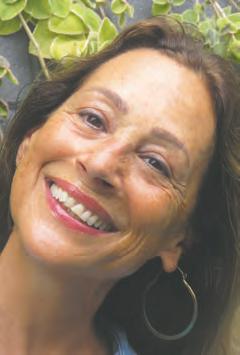
Classifieds | General: 206-461-1300

2 NOVEMBER 2022
© 2022 Pacific Publishing Co. Inc. Physical address | 636 South Alaska Street, Suite E2 Seattle, WA 98108-1727 SUBSCRIPTIONS 461-1300 Mailed | First Class $36/year Newsstand 25 cents
STAFF Editor: Jessica Keller, 206-461-1300 ext. 3 or MPTimes@pacificpublishingcompany.com Subscriber Services | Circulation: Christina Hill, 206-461-1300 ext 2 Letters policy: Letters to the Editor — whether sent via regular mail or e-mail — must include an address and a telephone number at which you can be reached for verification. Unsigned letters will not be published. Letters are subject to editing. www.MadisonParkTimes.com Circulation 5,500 Madison Park Times Woodside, Woodside & Eckart Dentistry Comprehensive Dentistry for the whole family Located in the heart of Madison Park 1901 42nd Ave E • (206) 323-3255 madisonparksmiles.com Seattle Metropolitan Magazine “Top Dentist” Dr. Collins Woodside Dr. Chet Woodside Dr. Tammy Eckart To advertise: Call Tammy 253-254-4972 ppcadmanager@pacificpublishingcompany.com Look Good, Feel Great, Stay Healthy A good day in our inner city
Mary Lou Sanelli Falling Awake
Embracing the Winter Blues
By Steve Lorton Tree Talk
November is here. Days from now through the end of January are as short as summer days are long. The sun comes up and creeps low across the horizon. The sky is often overcast, and drizzle seems the norm. For many, this ushers in the Winter Blues.
Need an antidote? Embrace the Winter Blues — in this case, with a wonderful palette of conifers that can enliven a winter garden and make you happy to look out your window or putter outdoors in their cultivation. These conifers, backed by our silverly gray skies, bejeweled by raindrops and artistically placed in the garden, can make the monochromatic nature of our winter landscape come to life.
Three genera of conifers offer the best blues: false Cypress (Chamaecyparis), junipers (Juniperus) and spruce (Picea). All three have cultivated varieties that fit into the three categories of use in the garden: spillers (low growers or ground covers), fillers (the plants that grow between 3 and 6 feet, providing anchors for mixed borders) and pillars (the tall conifers that serve as backgrounds and privacy screens). The trick is to pair them with other plants for contrast that make the blue pop.
The selection of blue conifers is vast. Here in the Pacific Northwest, we’re in the epicenter of it all. The Portland area alone boasts 14 nurseries that specialize in conifers. November is optimum planting time. Cool, moist overcast days are perfect for getting plants in the ground and established, ready to surge into growth with spring.
The Spillers
Among the multitude of choices, several come to mind that are particularly dazzling. Blue Star Juniper (Juniperus squamata ‘Blue Star’) and J. scopulorum “Blue Creeper” are tight and compact, perfect for rock gardens or to cascade over a retaining wall. For a heftier look, try the low growing, spreading spruce, Picea pungens “Glauca Prostrata.” This spruce will sprawl out in a gleaming, irregular mat in the front of a border or next to a patio where it will be a living sculpture without
blocking the view to the garden beyond.
Jane Platt, whose famous garden in Portland, Ore., was featured in the Rosemary Verey book “The American Woman’s Garden,” had an enormous prostrate blue juniper. Under and through this mass of intricate branches covered with stiff needles, she had planted prostrate Scotch broom Genista pilosa “Vancouver Gold.” The shoots of the broom made their way up and through the near-turquoise spruce, contrasting their small, roundish bright green leaves with the blue conifer needles. In spring, the plant bloomed profusely with sulfur yellow flowers. It was, to use a Rosemary Verey word, “rhapsodic.” In winter, the broom defoliated, and its unobtrusive naked branches were hardly noticeable.
The Fillers

The Chamaecyparis lawsoniana “Blue Surprise” in the photograph shimmers against that red brick wall, turning the garden gate into a striking entry. For a hotter, drier location, you might try a juniper that is similar looking put more prickly to the touch: Juniperus “Wichita Blue.” Again, the choices are many. When planted in front of a large deciduous tree, the conifer is complemented by the leaves, and perhaps flowers, in spring and summer. It helps the autumn color vibrate with its contrast and draws the eye to the winter filigree of branches behind it. With a red or yellow twigged dogwood in front of the planting, the whole ensemble is enough to send Monet, Renoir or even Van Gogh scrambling for their brushes and canvas.
The Pillars
Likely the most-well known among these is the Colorado Blue Spruce: Picea pungens glauca with a number of selections (“Fat Albert,” “Hoopsii,” “Koster” and even a weeping form, “Pendula”). The trick to getting the right blue spruce is to buy it after seeing it and confirming the blue for yourself. They can vary in hue from grower to grower. Any of them will need a spot with full sun exposure to really blue-up, but treated properly it can be bright light blue, headed to silver. It is said that one can increase the blue color of the plant by adding
aluminum sulfate to the soil, pounding rusty nails into the ground around the tree’s base or watering with Epsom salts — techniques worthy of consideration, albeit all untested by this gardener.
Chamaecyparis pisifera “Boulevard” is a much-loved Japanese native. It is a silvery blue conifer that was widely planted around the urban Pacific Northwest in the 1950s and ’60s. Most books say that this tree reaches 8 feet. Here, it grows to 20 or more in time. Tucked in among our dark green natives or paired with a golden needled conifer, these trees will play off the tarnished silver of our winter sky to produce a soothing, meditative vignette. The limbs coming off the main trunk can be selectively pruned to give the tree an open, airy look.
Bought now, any of these conifers can be slipped into a decorative container to hide the nursery can it came in, enlivening a deck or entry way and the festivities ahead in the coming months. Blue conifers are especially showy embellished with silver ornaments.
Don’t allow our seasonal gloom to get you down. Give yourself and your garden a holiday present. Select a blue conifer or two. Planted in the right place with the right companions, you’ll have a winter focal point to catch your eye for a lifetime. You’ll be unaffected when the sun takes its annual sabbatical each November. Instead, you’ll be singing the praises of these remarkable plants through all your winters to come. Your gardening will be singing, too — singin’ the blues.
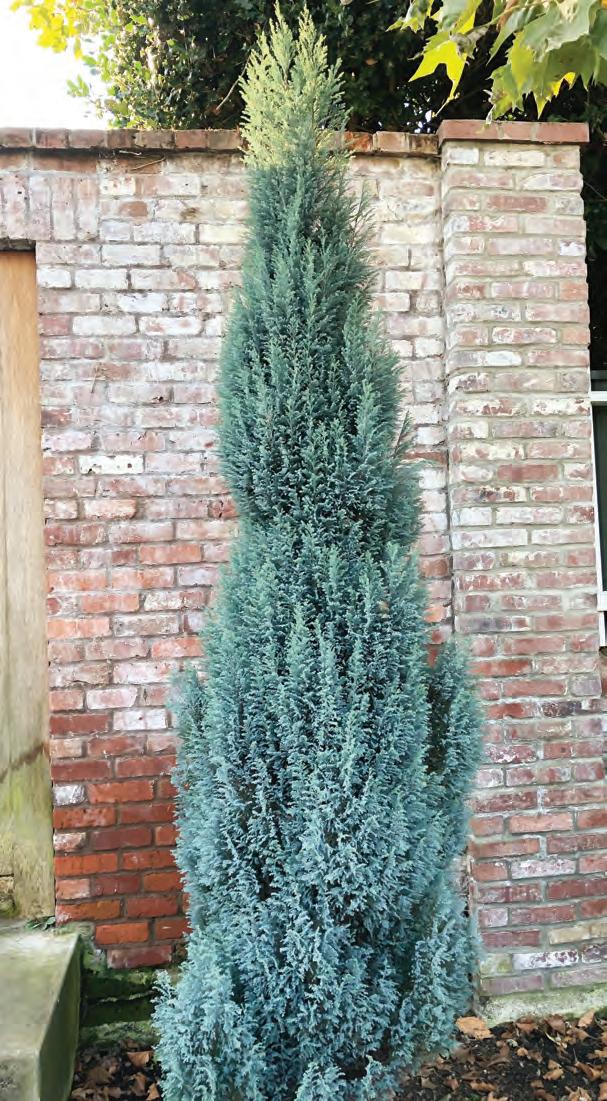
3 Pacific Publishing Company – Queen Anne & Magnolia News • Madison Park Times NOVEMBER 2022
HELP WANTED Contact Christina at 206.461.1300 or comprint@pacificpublishingcompany.com Pressroom Assistant No experience necessary. Must have exceptional attention to detail. Flexible hours. Ability to operate a forklift a plus. Pre-Press Technician Will train candidates with software suite experience. Must have exceptional attention to detail. Part-time exible hours.
Photo by Mary Henry Conifers, such as junipers, false Cyprus and spruce can liven up any winter garden, and November is the optimum planting time. These conifers can make the monochromatic nature of winter come to life.
I do not care for needles Studded tires allowed in Washington from Nov. 1 to March 31
By Richard Carl Lehman Revisiting the Park

One bright clear day on our way back to school after summer vacation, we were reliving our fun times. As we got closer to J.J. McGilvra, our moods began to change. Something was amiss. There was a smell in the air similar to that in a doctor’s office. Oh yeah, that piece of paper I brought home for Mom to sign was a permission slip to get immunized.
Looking back, the experience was a little like getting a six-penny nail driven into my arm. We never clearly understood that this was for our own good. Excuse me, “good” was sharing a hot fudge sundae at the Madison Park drugstore fountain lunch counter. And besides, we still got chicken pox, the measles and worse — the mumps! There just wasn’t any real explanation why we had to get shots. There was no proof until the day we saw signs on Madison Beach that stated: “Polio Epidemic — Stay Out.”
“What is polio?” At a Saturday matinee downtown, we viewed a seldom seen feature showing a person living in an iron lung. He had polio and was highly contagious. When he spoke, he paused, and air filtered into his lungs.
That short visual really hit home. It wasn’t that bathing beaches could cause polio, but polluted water did. Children under 5 were most susceptible. People followed the advice, stayed away and got vaccinated. Dr. Jonas Salk created the first successful vaccine, testing himself and his family in 1953.
We reacted to a lot of things that hampered our lifestyle. Things like, “Close the door, do you want to catch pneumonia?” On any given warm spring day, when you realized you didn’t have your English report done, it seemed time to “stage right” “Cough! Cough!” “Oh dear, you must have a chest cold. You stay home today.”
It was necessary to lay back, eat soup, drink hot chocolate and read those new Dell comic books. Except then came the hot wool (barbed wire) vest with mentholatum ointment smeared on it. The smell, the itch, it was enough to make you sick. Time for the flu shot. Madison Park’s Dr. Harris visited our homes to administer those. So many people caught it that companies had to crack down due to 50 percent or more being on sick leave.
During the World’s Fair in 1962, a naval ship was quarantined with no shore leave. They carried a new strain of flu that was the worst since the Spanish flu of 1918.
In the late ’50s, our 84th Engineers Airborne unit was put on alert. First order: get shots updated. With a copy of the shot record in hand and the original, we formed a line outside the orderly room. Once inside we handed over our copy and received shots. When it was my turn, I said, “Sir, I only have the original, and I am keeping it on my person.” The major asked, “Are you not complying with an officer? Well, without proof, you will get them now.” Never argue with an officer. So, I handed him the shot
record and received my shots. Cholera and typhus vaccines had to be kept at a freezing temperature. It was 90 degrees plus at Fort Ord. After the shots, we all had the cold shakes and took many hot showers, but soon the water ran out. Not a good day. We were ready to deploy, but there was one problem: I had no shot record as the major had taken it. Guess what? I had to take the whole series again. Hello, shakes and showers!
Weeks later, while drinking at the Casbah in Monterey, a friend from S-1 Headquarters told me of a major with orders to Berlin who had lost his original shot record and that he too had to retake the series. Knowing what I had gone through, this friend felt obliged to show me that he had the major’s original shot record. There is justice, after all. Plus, our deployment overseas fell off. It was a good day at long last.
Courtesy Washington State Department of Transportation
While many may be thinking about pumpkins and spiced ciders, now is the time for travelers to make sure they’re prepared for winter driving.
The Washington State Department of Transportation urges all travelers to start preparing themselves and their vehicles for winter weather. Drivers can check out WSDOT’s winter driving web page for tips and information. WSDOT also asks travelers to always “know before you go” and get the most upto-date roadway information before heading out.
Crews are already prepping for winter, including hiring additional workers for peak winter months. While significant effort and progress has been made towards hiring, there is still a nationwide shortage of Commercial Driver License drivers for plows and other vehicles. This means it’s even more important for travelers to be prepared to avoid preventable crashes or closures this winter.
Most mountain pass closures are due to preventable spin outs or crashes from vehicles driven too fast or not having proper equipment. WSDOT encourages all travelers to work together, be patient and prepared to help keep traffic moving.
To check conditions and prepare for winter weather:
• Check current travel conditions and download the WSDOT mobile app.
•Follow WSDOT’s regional and pass accounts on Twitter, the agency’s Facebook site and online travel alerts.
• Sign up for email and/or text updates about road conditions, https://service.govdelivery.com/accounts/WADOT/subscriber/new.
provides an online list of stateapproved alternative traction devices on its vehicle equipment webpage under “traction tires” These approved alternatives meet state traction tire requirements. All travelers are reminded to prepare for changing weather conditions and avoid a costly ticket by carrying chains or approved alternatives whenever crossing mountain passes. Failure to obey a tire chains sign can mean a ticket of up to $500. Special chain enforcement patrols will be keeping an eye on mountain passes this winter.
Studded tires By law, studded tires are legal for use in Washington state only from Nov. 1 through March 31. This applies to all vehicles in Washington, even those traveling from other states, and no personal exemptions or waivers exist.
WSDOT estimates studded tires cause between $20 million and $29 million in pavement damage to state-owned asphalt and concrete roadways each year. Motorists are encouraged to visit a tire dealer to learn about options, including stud-free, winter tread traction tires. This type of tire is different than an all-season tire, is legal year-round and does not cause the same roadway damage as studded tires. More information about studded-tire restrictions and requirements can be found in the Frequently Asked Questions on the WSP website.
LINKS:


Winter driving web page: wsdot. com/winter/
Current travel conditions: wsdot. com/Travel/Real-time/Map/ WSDOT mobile app: wsdot. wa.gov/travel/travel-informationphone
Twitter: wsdot.wa.gov/travel/ travel-information-phone Facebook: facebook.com/WSDOT/
“States and Nations”
“States and Nations”
And then, there is now. There were and are so many unknowns about COVID-19. The segregation of family and loved ones, restaurants closing, takeout remaining popular, walking around Madison Park with a cocktail in hand is not the norm now, but that was fun. Masks seemed to help, and for the most part people complied. The vaccinations were a godsend to many needing answers and a farce to others who questioned their validity.
After flying to Medford for a reunion, we noticed that on both flights there were small children with colds near us. When we got home it was time for that last booster, which affected us for a day. Not three days later, Karen came down with a mighty cold that might have been prevented if she’d worn an N95 mask for the duration of the reunion, the flights and the airport. Might as well say we are living in a petri dish.
• Text “468311 with the words “WSDOT Snoqualmie” to receive text message alerts about significant delays on I-90/Snoqualmie Pass.
• Download, print and carry the WSDOT Winter Driving Guide.
• Get vehicles ready and plan extra time to cross all mountain passes, including heavily traveled routes such as Snoqualmie Pass, Stevens Pass and White Pass.
• Carry chains and know current traction and chain requirements for mountain passes, which are also available on highway-advisory signs, highway-advisory radio and by calling 511.
• Preset your radio to 530 AM and 1610 AM for WSDOT’s traffic-information stations.
• Alternatives to chains Although some vehicle manufacturers recommend against the use of tire chains for certain models, that doesn’t excuse travelers from state traction device laws. These requirements exist to help keep all traffic moving safely during extreme winter conditions.
The Washington State Patrol

Sign up: govdelivery.com/accounts/WADOT/subscriber/new


Winter Driving Guide: com/ winter/files/winter-driving-guide. pdf
Get vehicles ready: wsdot.com/ winter/files/winter-driving-whatto-carry.pdf
Current traction and chain requirements: wsdot.com/travel/ real-time/mountainpasses
Vehicle equipment webpage: wsp. wa.gov/driver/vehicle-equipmentrequirements/
Estimates studded tires: wsdot. wa.gov/engineering-standards/ construction-materials/pavementdesign-management
Frequently Asked Questions: wsp.wa.gov/i-want-to/frequentlyasked-questions/
WSDOT keeps people, businesses and the economy moving by operating and improving the state’s transportation systems. To learn more about what we’re doing, go to wsdot.wa.gov/news for pictures, videos, news and blogs. Real time traffic information is available at wsdot.com/traffic or by dialing 511.
4 NOVEMBER 2022 (Family, Arts, Mentoring, and Enrichment) Community Center
FAME COMMUNITY CENTER (Family, Arts, Mentoring, and Enrichment) Community Center presents the Virtual Event
November 12, 2022 1:00 pm - 3:00 pm
Meeting ID: 841 3478 7450
year's goal is to
$75,000 Donate Today! http://www.mlkfame.org and click the donation button or mail to MLK FAME Community Center 3201 East Republican Street Seattle, WA 98112 ank You for Your Support!
MLK
Saturday,
ZOOM
Passcode: 2022MLK is
raise
FAME COMMUNITY CENTER (Family, Arts, Mentoring, and Enrichment) Community Center presents the Virtual Event
November 12, 2022
1pm - 3pm
Meeting ID:
MLK
Saturday,
•
ZOOM
841 3478 7450 Passcode: 2022MLK
MLK FAME Community Center 3201 East Republican Street • Seattle, WA
You
Your Support!
This year’s goal is to raise $75,000 Donate Today! http://www.mlkfame.org and click the donation button or mail to
98112 Thank
for
Cat person versus dog person
 By Ned Porges Guest columnist
By Ned Porges Guest columnist

There is much divisiveness in this world of ours: guns, masks, politics, women’s health, foreign invasion and the list continues. However, there is one more that ought to be on the list, even if last. Mentioning it will hopefully bring a grin to your face. The question is: Are you a dog or a cat person? Until a few years back I thought I was a cat person. Then, not abandoning my feline affinity, I became a dog person. Let me explain.
Right after World War II, my family had moved to Cambria Heights in Queens, New York City. Within a block from home was Public School-147. I had just walked home from my first-grade class and found a black cat sitting by the front door. It stayed with us for a few days until an older boy came knocking on our door. He was looking for his pet cat. The friendly cat was his.


My older sister by seven years and I were so disappointed. I cried; she wanted a pet cat. A few days later, my father, Walter, a high school teacher in Manhattan, brought home a kitten. My younger brother, Norman, my sister, Bobbie, and I were so happy. My sister named the cat Butch. He turned out to be more Bobbie’s pet. Butch was a typical-looking male alley-cat who spent much time outdoors. In early evenings Bobbie would call out and whistle for him to come home. Butch would come running from down the block. My mother grimaced when Butch rubbed against her leg in the kitchen just before feeding time. Mom was not a cat person.
Prior to the advent of real cat litter, my dad would drive us to Rockaway Beach to fill some buckets with beach sand. This would be the cat litter. My job was to scoop the lumpy sand from Butch’s box and replace it from the buckets stored in the basement furnace room.
During that time, we had a nextdoor neighbor with a Germanic surname who my dad thought of as antisemitic. This was just after World War II, and we were among the few Jews in the neighborhood. These neighbors had two children, an older boy and a younger sister about the same age as me and my brother Norman. We shared a common driveway with them, and the boy would caution me not to cross the mid-line. They had two miniature Dobermans that would menacingly bark at the sight of me and my family. This did not instill in me a love of dogs.
At around three years, Butch suddenly became sick. He would lay around the house and not eat. One morning before school, Butch tried to walk upstairs from the basement and died. Dad took him in the car and left for the day. We didn’t find this out until later that day. Dad was convinced the neighbor poisoned Butch because the cat walked on his lawn, and his dogs would go crazy. That was the end of having a pet for a long time. This was around 1950, and I was 9 years old. It was 1965 New Year’s Eve and
I recently graduated from Denver University. I had rented a small, one-bedroom house in the industrial suburbs of Denver. I had a date but no plans for the evening. I mentioned wanting a pet cat. So, we looked in the daily newspaper classifieds at pets for sale. I called one ad and went to their home for a kitten. It was the last of the litter, a male Siamese, with blue crossed eyes, cute. On the way home we stopped at a store for, this time, real cat litter and some canned cat food. I took my date home around midnight. The next morning, I left early for Colorado Springs to watch the annual Pikes Peak motorcycle hill climb. When I came home that afternoon, the kitten was frightened and refused to come from hiding behind the refrigerator. We soon reconciled and I gave him the name Sammy. I wanted to use the initials P.S.D., as in Phi Sigma Delta, but never came up with a P or a D. So, Sammy it was.
Within a few months, I packed my minimal belongings in my green camp trunk and took it to the United Airlines freight office at the airport. We were on our way to Los Angeles and my airline job at LAX. I had a little red Volvo P1800 sport car. Into it went a few items, including a favorite dismantled chair and Sammy the cat. We made it to Los Angeles and rented an over-thegarage one-bedroom studio from my mother’s cousins. Sammy and I lived there for a couple years and then moved to a larger apartment a few blocks away in the Hollywood area. Sammy took to the new environment and continued to enjoy the outdoors and knew his home. It was there, in 1972, that I met a bright, educated, attractive young woman. Six months later she became my wife and she brought along her two cats. Now there were three beasts. Less than a year went by when we were driving with our three cats, on our way to Richmond, Virginia. We both graduated with masters degrees from Virginia Commonwealth University, and we decided to move back to the West Coast. We opted for Seattle and my new faculty appointment.
With a small camping trailer behind us and our Audi, we were enroute to Seattle, adventuring across the plains of Canada. Somewhere along a westward Canadian route, we stopped overnight at a campground on a large open field of dry grass. We let the cats out of the camper as usual the next morning, but for some reason Sammy decided to run across the field and disappeared in the woods. We were packed and ready to continue the trek but no Sammy. We waited for quite some time. Sadly, I decided that was the end of Sammy and me. As we were about to leave, we saw
Sammy running across the field, and he leapt into the camper. I was so relieved and on we went.
The five of us settled into Seattle. In 1978, we moved from a rented house in Capital Hill. We bought a nice comfortable house a short distance in the Portage Bay neighborhood. We all blossomed and welcomed our first-born son and a couple years later, our daughter. Our three cats thrived, but Sammy the cat was getting old. He slowed down, didn’t run around much, ate less, lost weight, I knew it was getting close to the end of our 12-year relationship. I built a small coffin for him. Some months later I came home from work and learned he died. I put Sammy into his wood coffin. My wife called a few of the neighbor children to be at the funeral. He was buried in the back yard next to the garage. Sammy was the first and only pet of my own. We lived together for 12 years in six different homes, traversing North America twice. I was so saddened by Sammy’s departure. The next day I couldn’t go to work. It was the end of a memorable bond. Occasionally, looking through my small box of stuff, I look at his pet tags with the name and address of “Sammy the Cat.”
Years later in August of 2007, I remarried. She was a dog person, allergic to cats. She and her now grown two kids raised a standard black poodle they adored. Pictures of the dog were on the walls. Sadly, the dog died before his time after he was hit by a car in the street in front of the house in Denny-Blaine.
We had a friend in Madrona, an attorney, diagnosed with a terminal
cancer. He was failing fast and asked if we would take his 1-year-old dog to be our own. Knowing I never had a dog, my wife conferred with me, and I said yes. If it wouldn’t work out, there was another Seattle couple that agreed to take the dog. The dog’s name was Mickey. He was a big, black standard poodle weighing about 70 pounds. We picked up the dog, his doghouse, his sleeping pad, food dish and water bowl, harness, leash, poop bags, toys and other necessities. This was not a cat.
The first night here, I put Mickey in the basement. Not a good choice. He whimpered for hours until we brought him upstairs. That was his last time with separate sleeping arrangements. The rest of his years his sleeping quarters were in the spare bedroom. Mickey was well on the way to being trained. First, he would stop at the curb before crossing. He knew putting on his harness meant going for a walk. I don’t know how, but he was a fast learner, a visual force that people would ask about. Within months, he learned reluctantly to jump through a hoop, to shake, sit, speak, lie down, wait for an OK to eat a snack, time for bed and more. The only thing he wouldn’t do is to return a thrown ball. Don’t know why. We had a dog walker for many years. Mickey-the-Dog, as I called him, would wait at the door, harnessed and ready to go. Carl, the dog walker, said Mickey assumed leadership of the seven or more leashed dogs.
Mickey had long legs. He was big and easily jumped into the back of our car. He was so gentle with guests, grandchildren, neighbors. He was a fixture in the neighborhood. I learned to be dog appreciative, especially of full-bred poodles. I took him everywhere. He became my buddy.
Mickey had a haircut and trim every few months, ran around at various King County and Seattle dog parks and had regular Madison Park vet checkups. I came to learn that larger dogs have shorter life
spans. After about 11 years Mickey began to slow down, didn’t have the same vigor or appetite. He no longer jumped up to greet someone or when a car parked in front. We took him to the veterinarian and learned the sad news that Mickey had a wide-spread cancer and would soon die. After we brought him home, a hard decision was made. We would have him “put down” to prevent his suffering. A couple days later, this time we helped Mickey into the car. We three walked slowly into the vet office. She was waiting for us. Mickey was lifted onto a table. Lying down, he was injected. Looking at us, he closed his eyes and quickly was gone to dog heaven. We were so sad, and the vet staff were so kind. We took home his harness and dog tags.
I am now in my 81st year. It’s been about 75 years from first having a pet named Butch, then Sammy and then Mickey. In retrospect, I feel honored to have three pets, an alley cat, a Siamese cat and a French poodle. I doubt there will be another fourlegged pet in this household but am glad to have had the experience and do welcome occasional pet sitting for our daughters.
So, am I a cat or dog person? I am neutral but love and admire both species. They are unique and are worthwhile family members. See you again someday my friends, Butch, Sammy and Mickey-the-Dog.
5 Pacific Publishing Company – Queen Anne & Magnolia News • Madison Park Times NOVEMBER 2022
capitol hill • madison valley 206-329-5187 Admissions@HarvardAvenueSchool.com HarvardAvenueSchool.com exceptional programs waddler toddler preschool pre-kindergarten social emotional academic artistic In Madrona 1421 34th Avenue Tues-Sat: 11am-6pm Instagram + WWW @nidoseattle_ritababy nidoseattle.com Avant Toi • Caddis • CP Shades • Francesca Lacagnina Gilda Midani • Hansel From Basel • Jaga • KAS • Labo Art Le Sarte Pettegole • Lis Lareida • Lola Hats • Magnolia Pearl Manuelle Guibal • Origami Crane • Roy Rogers • Rundholz Saint Rita Parlor • See My Toes • Shannon Koszyk • Sskein clothing and more for women and men
The power of ham radio
As a child, I remember being fascinated by telegraph communications, especially when I learned about Morse code, a secret language I wanted to learn.
Moving into adulthood, I learned this language of dots and dashes was used with the development of wireless or radio communications around the world. It was an intriguing feature of the drama of early war movies. I’m revealing my senior citizen status here, and with the development of new technologies, the world of amateur or ham radio operators slipped off my mental screen.
While the use of Morse code is less prevalent today, ham radio communications are certainly not a thing of the past. (For an interesting read, check out the etymology of the term “ham” for an amateur radio operator.)
Amateur radio is a popular hobby as a way to talk to people around the world — without cell phones. The Boy Scouts offer a merit badge for getting a ham radio license when you turn 18 years old.
In addition to the enjoyment of using ham radios, licensed operators serve as a cornerstone for communications in times of disaster when regular communication channels fail. Picture the 9/11 tragedy and the floods, fires and earthquakes that are a growing part of our daily reality.
In the Seattle area, as in many parts of our country, amateur radio operators are encour-
aged to become part of emergency communication hubs. If you are a licensed radio operator, consider connecting with your local emergency hub team. In Madison Park, long-time ham operator Bob Edmiston has spent over a decade volunteering as a cornerstone of our emergency preparation work. Bob is eager to share his knowledge and help others gain experience on the team before he leaves the neighborhood in the coming year. Bob stresses you don’t have to be “a techie” to get involved.
Susanna Cunningham, a licensed radio operator in a north Seattle neighborhood, says she doesn’t have an intuitive understanding of electronics, but she loves learning new things and knows she’s a scientist at heart. I spoke with Susanna about her choice to devote some of her retirement years engaging in amateur radio work after a career in nursing. What she described was some of the enjoyment of being involved.
Three reasons to become a volunteer Susanna recalled once hearing someone outline three reasons to engage in volunteer work:
• Volunteering allows you to be of service, to make a difference
• Volunteering offers a way to continue to learn new things
• Volunteering offers opportunities to have fun

“Especially in amateur radio work, I’ve met a whole group of people I might never
have otherwise encountered,” she said. “They are all terrifically willing to be helpful, and we’ve had fun together. For instance, during the intense period of COVID lockdown we played radio games in our cars, staying safe while roaming our neighborhoods to learn and radio interesting features to each other. Periodically some of us volunteer to work community events like foot races, transmitting information up and down the course. This is not only helpful for the event, but provides an opportunity for ongoing practice, giving our neurons something to get used to doing.”
I learned that some hams just have a handheld portable radio resembling a simple walkie talkie. Others like to build and experiment with electronics. Some enjoy competing in contests to see how many hams in distant locations with whom they can get in contact. Many use ham radio to form friendships over the air, an early form of social media.
How to get involved
Susanna pointed me to a national association for amateur radio, the American Radio Relay League (ARRL.org), as an easy place to learn more and find ways to get involved. This is a noncommercial organization in which active radio amateurs share information and get technical support and online resources. While you can listen in on communications, you can’t transmit until you get your license, so ARRL provides basic study materials and a listing by zip code of local groups for people who want more interaction.
Susanna said the test is really about memorizing material and, depending on what kind of a learner you are, you can access what you need through ARRL, including free practice
exams using questions from the actual FCC examination pool. Basic study materials for an initial license usually cost less than $40, and simple equipment can be purchased new from between $100-200, or often far less for good used equipment.
In the Seattle area, the Mike and Key Amateur Radio Club (mikeandkey.org) operates and loans from a constantly expanding free library, including electronic testing equipment to properly install and manage your operating setup station.
Toku Okumura is the library owner and can be reached at library@mikeandkey.org.
Giving and receiving
Once you have your license, a whole new world is opened up. This might include making an important contribution by getting involved in your local emergency hub communications. Our Madison Park Emergency Preparation Volunteer Team would welcome you with open arms and, if you join us soon, you’d have an experienced mentor in Bob Edmiston before he leaves the ’hood.
At the end of our conversation, Susanna Cunningham returned to the three reasons for volunteering — you can make a difference, learn new things and have fun.

“The experience is very reciprocal: You are giving, and you are receiving, just as you do with anything meaningful in your life,” she said. “It’s what friendships are about.”
To get involved with the Madison Park emergency communication hub, contact: • Sarah Armstrong: saraharmstrong215@ gmail.com
• Mary Beth McAteer: msimiele1@gmail. com
• Margie Carter: margiecarter@comcast.net

6 NOVEMBER 2022 The holidays are
around the corner. Feature it on our Madison Park/Madison Valley Holiday Page! Are you looking for an affordable way to reach your community with gift giving ideas, festive concerts and events, or taking reservations for New Year’s Eve? In print with the December issue of the Madison Park Times. Direct mailed into the neighborhood with 5800 copies distributed just in time for the holiday season. 1/8 Page | Full Color | Only $60! Space and Copy deadline is Wednesday, November 23rd @ Noon. Only 8 spots are available! Reserve today by calling Tammy at 253-254-4972 or email ppcadmanager@pacificpublishingcompany.com.
just
Margie Carter MP Emergency Prep
FINAL WORK PARTY OF THE YEAR PLANNED
Volunteers are needed to help prepare the Prospect Nature Preserve for winter at a final work party of the year, from 9 a.m. to noon Nov. 12 at the shoreline park at 41st Avenue East and Prospect Street, next to the Seattle Tennis Club in Madison Park. People can bring their garden gloves and favorite weeding tools if they have them. The work party will be doing a final cleanup and some mulching to put the garden to bed for winter. Contact interim steward Octavia Chambliss, 206-295-2979 or octaviagarden@ gmail.com, with questions.
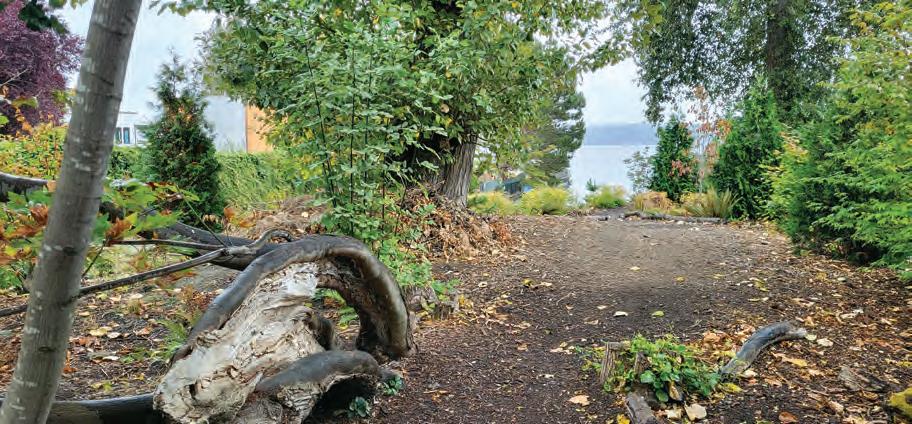
FUNDING FOR MAINTENANCE

Chambliss has also created a GoFundMe website to accept donations for the upkeep of the nature preserve, which was overrun with weeds, trash, beer cans and needles before it was turned into a shoreline park with access to Lake Washington. The funds will be used to help maintain the preserve, which is a large site and needs more than volunteers alone to thrive. See this story on the Madison Park Times website to access the link, or visit https://bit. ly/3sxEE0w

VOLUNTEERS NEEDED AT PROSPECT NATURE PRESERVE
Preserve organizers are also searching for a co-steward or volunteer coordinator to ensure the shoreline park is available for future generations. The person or people would work with the city to arrange three to four work parties a year, ensure irrigation is maintained by the city and recruit volunteers for weeding, planting and mulching, as needed. Gardening experience is not necessary. Anyone interested should contact interim steward Octavia Chambliss at 206-295-2979 or octaviagarden@gmail.com.
PRESERVE
From page 1
more than 868 trees and shrubs planted at the site.
A real community effort is needed to help to ensure it stays that way, however.

Chambliss, who wishes to ease out of the steward position to focus on her family, is looking for one or more people to step into the steward or volunteer coordinator role at the preserve. Longtime volunteer Doug Berry, who is retired, has agreed to step in as a co-steward but would like someone else to help fulfill steward duties, as well. Chambliss said anyone can offer to help.
Chambliss said the steward role is not difficult, nor does it require an expert gardener to help maintain the site.
“It’s not like you have to know plants or gardening. Gene knew nothing about plants,” Chambliss said.


She said she has all the information on the plants growing there and their requirements and can help people identify the native plants from an invasive species.
Chambliss said Omar Akkari, the Seattle Department of Transportation Shoreline Street Ends project manager, is also knowledgeable about the plants and what trees and bushes are allowed at the site.
Chambliss said the steward’s job is to schedule work parties, oversee fundraising efforts, recruit volunteers and work with the city and tennis club to make sure the site stays watered.
“And really, that’s it. It’s not a huge responsibility,” she said.
Multiple people could even share the duties, Chambliss said, and she would like to see more people from Madison Park get involved to make sure the park is there for generations to come.
To help the nature preserve thrive, Chambliss has coordinated a GoFundMe account to raise money to backfill plants, purchase supplies and even hire a landscaping crew once or twice a year between work parties.
She said a savings account of around $2,000 would be ideal.
Preserve is finally established, the workload will become lighter, Chambliss said. She hopes that, by that time, more people will be involved and a sense of ownership in the neighborhood established.
Chambliss said. “It has so many possibilities.”

A dry summer and irrigation troubles have allowed weeds and invasive species to move in on the native plants at the Prospect Nature Preserve in Madison Park. A final work party to prepare the shoreline for winter is scheduled for Nov. 12.
The Prospect Nature Preserve at 41st Avenue East and Prospect Street in Madison Park allows residents to enjoy nature and access Lake Washington. More volunteers, stewards and funding are needed to help the preserve last for future residents.
7 Pacific Publishing Company – Queen Anne & Magnolia News • Madison Park Times NOVEMBER 2022 SENIOR HOUSING Service Calls Welcome www.kemlyelectric.com Lic # KEMLYE1038DR Panel Upgrades • Repairs Senior Discount 206-782-1670 Electric Company of Seattle WHY WAIT? Skilled Electricians Available Now! Panel changes and service upgrades our specialty! All types residential and commercial wiring. Stephen Brandeis, Master Electrician 206-633-3896 Lic.#ELECTCI020BN • service@elcose.com www.elcose.com Custom Masonry & Stoves, Inc. Fireplace and Chimney Repair LIC# *CUSTOMS077BE•BONDED•INSURED (206) 524-4714 • Since 1962 Please see our reviews & photos on Brick Home Restoration Tuckpointing / Rebuilding Pressure Washing Hilltop House www.hilltophouse.info Senior Only Living 62 and over (206) 624-5704 Subsidized Units Available Market Rate Discounts for First Responders and Teachers Nourishing Life for Seniors on First Hill since 1967 leasing@Hilltop-House.org Your Ad Can Be Here! Contact Tammy at 253-254-4972 Reserve your space for next week! HOME SERVICES HOME SERVICES RENTALS NEIGHBORHOOD MARKETPLACE CONSTRUCTION/HANDYMAN CHIMNEY/MASONRY ELECTRICAL SERVICES HOME SERVICES
Photos by Jessica Keller




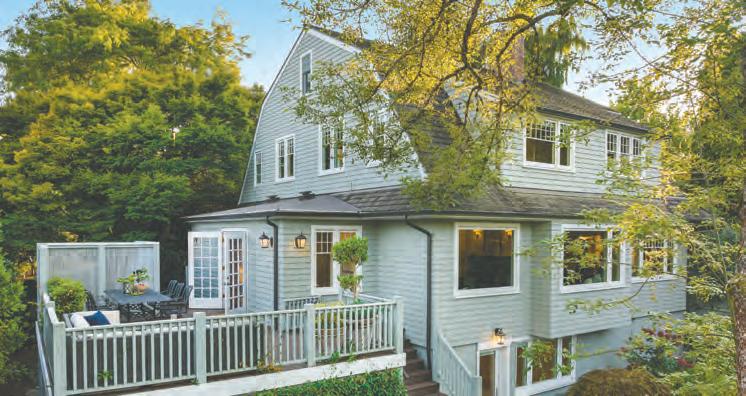


8 NOVEMBER 2022 1301 Spring St #20I, Seattle / MLS #1998228 FIRST HILL / $1,545,000 Holley Ring & Ellen Gillette / HolleyRing.com & MakeSeattleYourHome.com 726 Boylston Ave E Unit #2, Seattle / MLS #2006116 THE HARVARD ESTATE – CAPITOL HILL / $1,495,000 Reilly D. Schanno / ReillySchannoHomes.com 3437 NW 56th Street, Seattle / MLS #1945053 BALLARD / $3,575,000 Jane A. Johnson / JaneAJohnson.com All in, for you. Once we know your goals, we won’t stop until you reach them. 3800 E McGilvra St, Seattle / MLS #2002932 MADISON PARK / $3,500,000 Shawna Ader & Shannon Laskey ShawnaAder.com & ShannonLaskeyRealEstate.com Julie Bouscaren / JulieBo@windermere.com 1526 37th Ave E, Seattle / MLS #1990336 MADISON PARK / $3,000,000 5220 57th Avenue S, Seattle / MLS # 1997752 SEWARD PARK / $2,950,000 Susan Stasik & Shawna Ader / SusanStasik.com & ShawnaAder.com WINDERMERE.COM PREMIER LISTINGS W COLLECTION LISTINGS
Happy fall! If you follow the real estate market, you know that our region continues to rebalance back to a normal market.
The latest numbers from the Northwest Multiple Listing Service show King County active listings are nearly doubled from a year ago and pending sales are down.
However, prices in Seattle and on the eastside continue to rise, and that is true here in our neighborhood, as well.

Many buyers see the market re-shift as welcome relief, with a bigger selection and sellers who are willing to negotiate, but rising interest rates and inflation continue to be a challenge and contribute to buyer hesitancy. However,


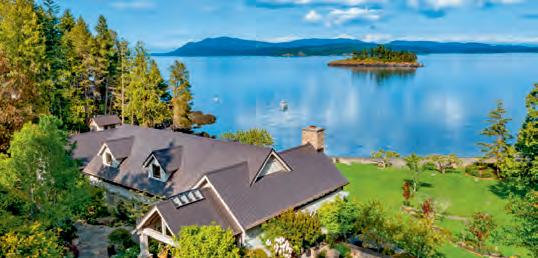



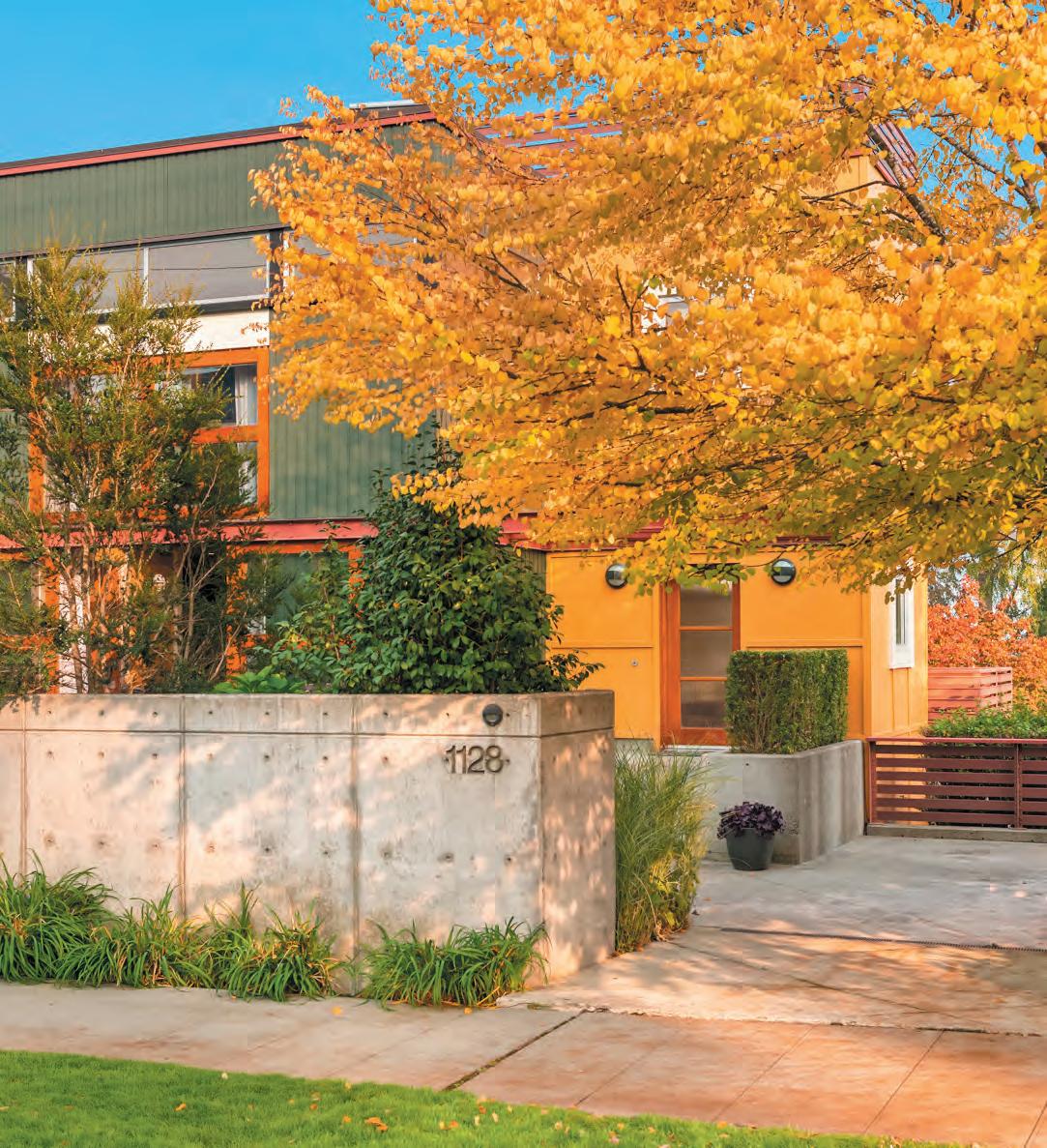
real buyers are in the marketplace, including those out there as a result of months or years of pent-up demand. For sellers, correct pricing is more critical than ever. Timing is everything; pricing should be neighborhood-focused and determined in real time instead of what was happening earlier this year. The purchasing power of buyers who will have financing has been diminished due to higher rates.
All these factors will contribute to the pricing adjustment we will likely see. Pricing too high out of the gate might cause your property to stall — work with an

www .M adison P ark T i M es co M
-
Real estate
NOVEMBER 2022 Serving East-Central Seattle since 1983 MOIRA E. HOLLEY moirα@moirαpresents com 206.612.5771 moirαpresents com Stunning Leschi Residence: $1,895,000 C o l d w e l l B a n k e r B a i n S A N J U A N I S L A N D E S T A T E r e c e n t l y s o l d | $ 8 , 9 5 0 , 0 0 0 206.919.6605 | lisaturnure@cbbain.com | LisaTurnure.com For more information about this home or to see my other active listings and recent sales, please contact me via phone, email or see my website at lisaturnure.com. Experienced. Innovative. Trusted. L I S A T U R N U R E R E A L E S T A T E M I D - C E N T U R Y O N M A G N O L I A B O U L E V A R D o f f e r e d f o r p u r c h a s e | $ 3 , 7 9 5 , 0 0 0 H I G H E S T S A L E E V E R O N S A N J U A N I S L A N D D O U B L E L O T & U N O B S T R U C T E D V I E W S Rebalancing back to a normal market SOLD Street Number Selling Price 4211 E McGilvra St $776,000 1134 B 32nd Ave E $849,000 1128 B 32nd Ave E $849,000 2055 43rd Ave E #302 $865,000 2501 Canterbury Lane E #309 $875,000 1130 32nd Ave E $899,000 1132 32nd Ave E $900,000 2339 42nd Ave E #1 $955,450 2325 41st Ave E $1,085,000 1134 32nd Ave E $1,477,500 1128 32nd Ave E $1,485,000 2057 McGilvra Blvd E $1,488,000 1018 31st Ave E $1,600,000 2020 McGilvra Blvd E $1,685,000 2029 41st Ave E $1,766,000 210 35th Ave E $1,800,000 2044 41st Ave E $1,900,000 Homes sold July 18, 2022 through October 7, 2022. (Data courtesy NWMLS) Street Number Selling Price 1620 43rd Ave E #7B $1,900,000 1403 38th Ave E $2,050,000 1518 41st Ave E $2,200,000 2302 42nd Ave E $2,250,000 3715 E Howe St $2,410,000 1620 43rd Ave E #21-A $2,450,000 1605 42nd Ave E $2,600,000 1810 Broadmoor Dr E $2,630,000 1401 39th Ave E $2,700,000 2061 43rd Ave E #202 $2,750,000 1206 37th Ave E $2,975,000 2000 38th Ave E $3,050,000 1823 38th Ave E $3,500,000 1114 37th Ave E $3,630,000 2128 Broadmoor Dr E $3,650,000 1031 McGilvra Blvd E $4,655,625 1230 37th Ave E $4,670,000
MADISON PARK
WASHINGTON PARK - MADISON VALLEY - DENNY-BLAINE - MADRONA - LESCHI
Madison Park Times
SEE PROPERTY, PAGE 7
Evan Wyman Property Views
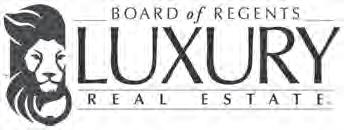
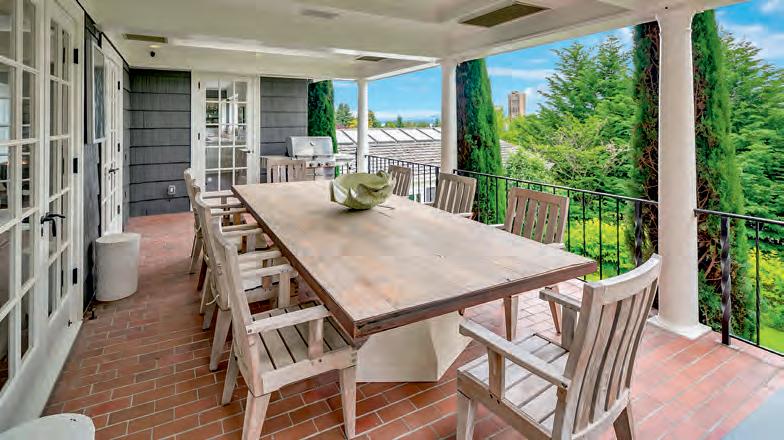


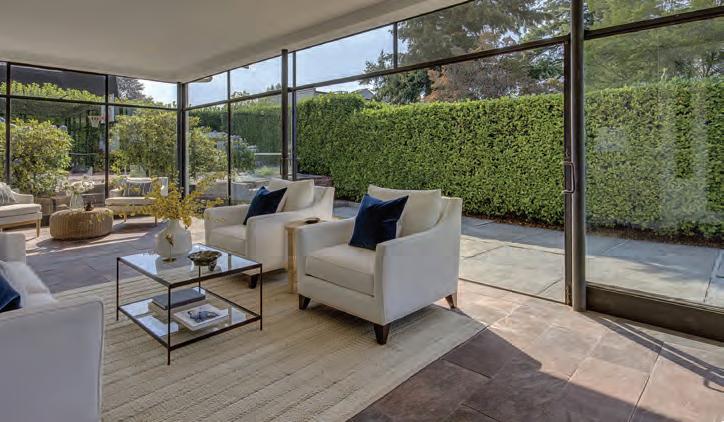




2 NOVEMBER 2022 206.322.2840 ewingandclark.com luxuryrealestate.com
BETSY Q. TERRY · JANE POWERS · KRISTINE LOSH · NATE PEARSON
CAPITOL HILL | $4,450,000
BETSY Q. TERRY & JANE POWERS
MAGNOLIA | $2,799,000
MADISON VALLEY | $949,000
WASHINGTON PARK | $11,495,000
LESCHI | $3,995,000
The healing power of gardens
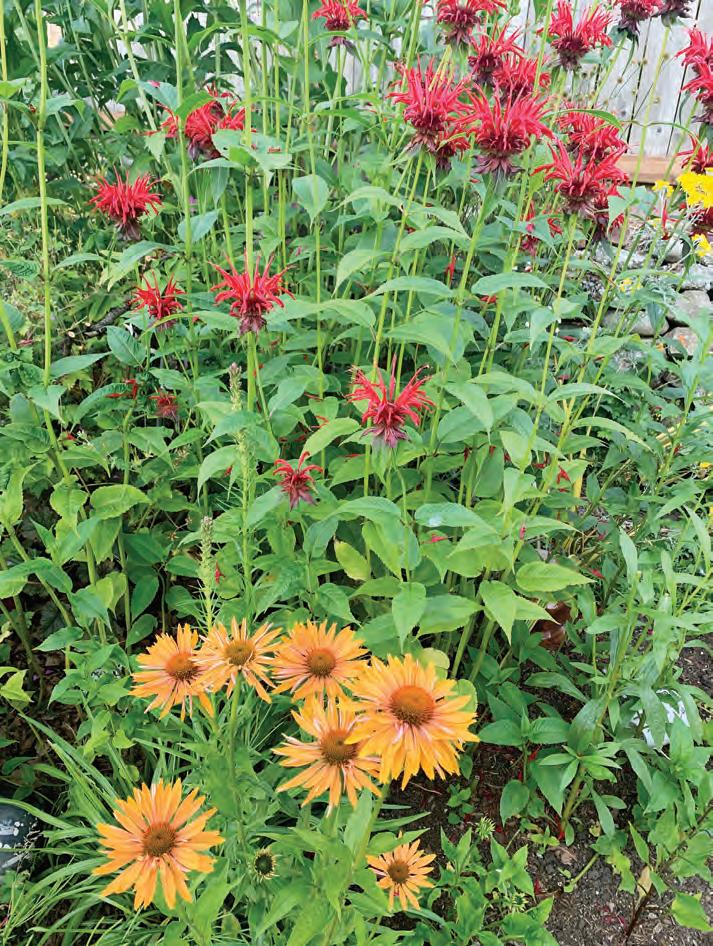
Being immersed in the garden does something special to you.
I think most gardeners have an instinctive understanding of this, the invisible connection with the land nourished by love and observation. One day years ago, I was wound up over something, and my husband called my attention to the brand-new “11” lines between my eyes. I then spent a couple of hours cleaning up in the garden. I don’t remember what specifically I was doing, but I remember washing my hands after finishing and looking in the mirror to find my forehead transformed back to a magically smooth landscape. Since then, I head to the garden as often as possible, but especially if there’s some tension to release.
This column has discussed before the healing benefits of nurturing someone else — be they animal or plant. Nothing propels you out your personal worry-sphere more than helping others. There is something about giving that replenishes us, that feels innately right.
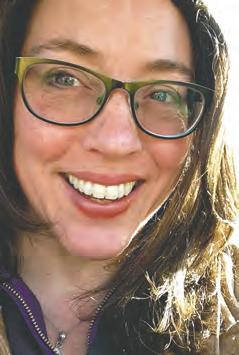
Horticultural therapy programs, popular in assisted living and correctional facilities, nurture the tenders along with the tended. There are also the mood-lifting effects of exercise and movement, whether that’s weeding or hauling boulders for a new rock wall.
Ironically, as science advances, it is
confirming this ancient, hidden-in-plain-sight truth that man is part of nature, not separate or above it, as humans sometimes like to think.
Influencers of the external kind
For instance, the term “epigenetics,” which has exploded as a study in rece ans evolved to wake, sleep and eat in sync with our bodies’ circadian rhythms, and our bodies notice when we fall out of sync.
Some inputs of epigenetics are tangible, such as fresh air or smoke, healthy vs. unhealthy bacteria. Others might be invisible or unconscious to us but send clear messages to our body and mind. Our microbiome and our exquisitely sensitive nerve system continuously scan the environment for signs of safety or danger, sending signals and creating a feedback loop of emotional and physical chain reactions perpetuating the body’s interpretation of that input.
The power of dirt
Soil contains a bacterium that can raise serotonin levels like an antidepressant would. The bacterium (Mycobacterium vaccae) when inhaled, absorbed through hands in the dirt or through abrasions, has been shown to improve moods of human cancer patients, and in rat studies to raise serotonin for up to three weeks. Serotonin
SEE GROWING, PAGE 6
What My Clients Are Saying...
Founding Member | Managing Broker Senior Global Real Estate Advisor 206.399.5842 | Laura.Halliday@rsir.com
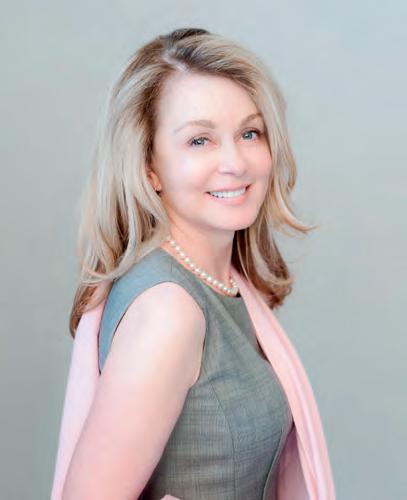
BROADMOOR | OFFERED AT $6,980,000



“It's very easy to write a rave review for the agent that helps you find your dream home but what about the agent that LISTS your dream home? While divorce may line the pockets of many an agent, it has to have them reaching for the jumbo bottle of Maalox. In our case, the only thing my former spouse and I could agree on was using Laura Halliday as our agent. We have known Laura both professionally and socially for over 20 years. Her reputation as a top agent is hard-won and well-deserved. Meticulous in her approach, she is knowledgeable, consultative, and respectful. Our house was listed and closed in 6 weeks. We are so grateful. Laura's ability to get everyone singing from the same hymnal in a very acrimonious situation was invaluable. We recommend Laura without reservation."
-
Janet Jones
PROVEN RESULTS
A CONTINUED LEGACY
Realogics Sotheby's International

Realty ranks amongst the largest, most productive, and fastest-growing real estate companies in Washington with access to 25,000 brokers in 79 countries and territories generating global sales of $204 billion annually.

SOTHEBY’S AUCTIONS

Sotheby’s Auction House Presents 20th Century Art: A Different Perspective, a showcase of both modern and contemporary works by artists from Central and Eastern Europe held at Sotheby’s Cologne.
1642 Shenandoah Drive East Who knew that a simple change of heart could present such a seductive opportunity for a buyer? Purchased two years ago with plans to take this Spanish Revival home and turn it into a Santa Barbara estate then, as it happens sometimes, plans changed. All new flooring, appliances, fixtures, painting, carpet, light fixtures—well, everything! On a sought-after double lot, this home was great then and will be swoon-worthy very soon! Curious? Reach out for a buyer’s packet with all the delicious details. Did I mention there are over $800K of new high-end finishings curated by designer Brian Paquette and a full re-landscape of the front garden for $183K included in the price? Turn-key luxury living! Elegance, indulgence, and value.
LauraHalliday.com

3 NOVEMBER 2022 Pacific Publishing Company – Queen Anne & Magnolia News • Madison Park Times
Each Office Is Independently Owned And Operated. Seller reserves the right change the product offering without notice.
Erica Browne Grivas Get Growing
Studies show growing things and being in the garden have many benefits beyond beauty.
Photo by Erica Browne Grivas
Seattle Public Library hosting November, December events and dialogues
By Laura Marie Rivera
The Seattle Public Library’s author programs, book discussions and community dialogues in November and December feature Oglala Lakota chef Sean Sherman; Pulitzer Prize-winning historian Ada Ferrer; cartoonist Megan Kelso; and poet and retired professional cage-fighter Jenny Liou.
Most of these events require registration. Find information and registration at event links or spl.org/Calendar. All Library events are free and open to the public.
EVENTS SCHEDULE
Chef Sean Sherman: “The Revolution of Indigenous Foods of North America.” From 7 p.m. to 8:30 p.m., Friday, Nov. 4. Central Library (Level 1 Microsoft Auditorium) and online.
Oglala Lakota Chef Sean Sherman, author of “The Sioux Chef’s Indigenous Kitchen,” will share his journey of discovering, reviving and reimagining Native cuisine. Born in Pine Ridge, S.D., Sherman’s main culinary focus has been on the revitalization and awareness of indigenous foods systems in a modern culinary context, opening The Sioux Chef in 2014. This is the second event in the fall public engagement series guest-curated by Seattle poet Shin Yu Pai. Supported by The Seattle Public Library Foundation and the Gary and Connie Kunis Foundation.
Kwame Alexander discusses “The Door of no Return.” From 7 p.m. to 8 p.m., Friday, Nov. 4. At Hugo House (1634 11th Ave., Seattle).
Join us to celebrate Caldecott and Newbery Award-winning author Kwame Alexander’s (“The Crossover”) powerful new book for youth. “The Door of No Return” is about an 11-yearold in 19th century Ghana named Kofi Offin,
who dreams of water and ends up in a fight for his life.
Presented with Elliott Bay Books and the Hugo House, and supported by The Seattle Public Library Foundation and the Gary and Connie Kunis Foundation.
Jack Straw Writers Showcase. From 2 p.m. to 3:30 p.m., Saturday, Nov. 5. Central Library (Level 1 Microsoft Auditorium). Members of the 2022 Jack Straw Writers program, selected by curator Michael Schmeltzer, share their work. Now in its 26th year, the Jack Straw Writers Program has included more than 250 Pacific Northwest writers who represent a diverse range of literary genres.
Supported by The Seattle Public Library Foundation and the Gary and Connie Kunis Foundation.
Cartoonist Megan Kelso in conversation with Phyllis Fletcher. From 1 to 3 p.m., Sunday, Nov. 6, Central Library (Level 1 Microsoft Auditorium) and online.
Phyllis Fletcher, a highly decorated editor, mentor and comics fan, interviews local cartoonist Megan Kelso about her new book of graphic short stories, “Who Will Make The Pancakes”?, her public art piece now installed at Climate Pledge Arena, and her early beginnings. This event is in partnership with Short Run Comix & Arts Festival.
Pulitzer Prize-winning author Ada Ferrer on “Cuba.” From 7 to 8 p.m., Monday, Nov 7. Online.
For the Bullitt Lecture in American History, historian Ada Ferrer will discuss her Pulitzer Prize-winning book, “Cuba: An American History.” Spanning more than five centuries, this book provides us with a front-row seat of the evolution of the modern nation, with its dramatic record of conquest and colonization,
of slavery and freedom, of independence and revolutions made and unmade. Born in Cuba and raised in the United States, Ferrer has been conducting research on the island since 1990. This virtual event is supported by The Seattle Public Library Foundation and the Gary and Connie Kunis Foundation.
Ladies Musical Club Concert. From noon to 1 p.m., Wednesday, Nov. 9. Central Library (Level 1 Microsoft Auditorium). After a pandemic hiatus, the Ladies Musical Concerts returns. From October 2022 to May 2023, the Ladies Musical Club offers free classical music concerts on the second Wednesday of the month at noon. Enjoy local musicians performing vocal and instrumental pieces in diverse musical styles and periods. Registration not required.
Jenny Liou and Shin Yu Pai Discuss “Muscle Memory.” From 7 to 8 p.m., Wednesday, Dec. 7. Central Library (Level 1 Microsoft Auditorium) and online. Join us for a reading and conversation with poet, science writer, and retired professional cage fighter Jenny Liou, the final event in the public engagement series guest-curated by Seattle poet Shin Yu Pai.
In “Muscle Memory,” Washington-based poet Liou grapples with violence and identity, beginning with the chain-link enclosure of the prizefighter’s cage and radiating outward into the diasporic sweep of Chinese American history.
Supported by The Seattle Public Library Foundation and the Gary and Connie Kunis Foundation.

Contact the Library’s “Ask Us” service by phone at 206-386-4636 or by email or chat at spl.org/Ask. Staff are ready to answer questions and direct you to helpful resources and information.
The Seattle Public Library has added open hours at the Ballard, Capitol Hill, DouglassTruth, Madrona-Sally Goldmark, Montlake and Rainier Beach branches. Hours at these locations were temporarily reduced over the summer due to staffing constraints.
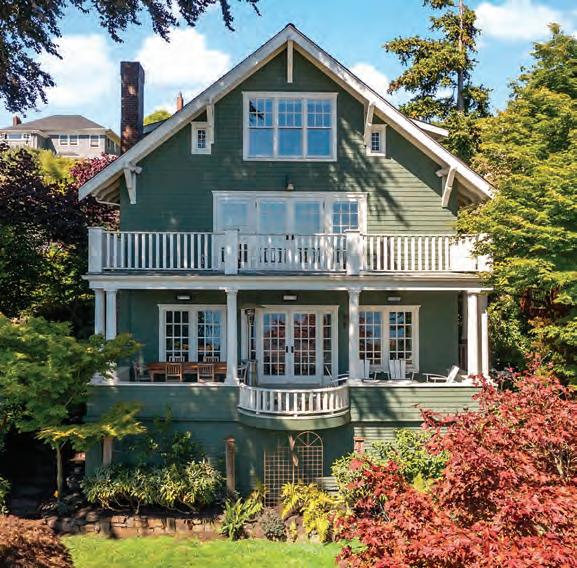
Changes to Library open hours include:
• Ballard Branch: Tuesday evening hours restored. Open from 10 a.m. to 8 p.m. on Tuesdays.
• Capitol Hill Branch: Thursday morning hours restored. Open from 10 a.m. to 8 p.m. on Thursdays.
• Douglass-Truth Branch: Wednesday morning hours restored. Open from 10 a.m. to 8 p.m. on Wednesdays.
• Madrona-Sally Goldmark Branch: Saturday hours restored. Open from 11 a.m. to 6 p.m. on Saturdays.
• Montlake Branch: Sunday hours restored. Open from noon to 5 p.m. on Sundays.
• Rainier Beach Branch: Tuesday evening hours restored. Open from 10 a.m. to 8 p.m. on Tuesdays.
In coming months, as staffing levels allow, more hours will be restored at additional Library locations where hours were temporarily reduced.
Current open hours for all branches can be found at spl.org/ Hours.
With over 34 years of real estate experience, we would love to be your real estate experts when it comes to marketing your home and purchasing a new home. We are excited to talk with you about your options!




4 NOVEMBER 2022
1220 42nd Ave.
KATHRYN HINDS Windermere Madison Park 206•650•6488 KATHRYNHINDS@COMCAST.NET HINDSTEAM.COM TAYLOR HINDS Windermere Madison Park 206•434•5102 TAYLORHINDS@WINDERMERE.COM HINDSTEAM.COM KATIE HINDS Windermere Madison Park 206-434-5103 KATIEHINDS@WINDERMERE.COM HINDSTEAM.COM
SOLD $6,000,000
3257 Lakewood
1427
949 N 35th St #105 PENDING $365,000
Ave S SOLD $2,485,000
LakeBlvdWashington
S SOLD $2,100,000
LISTING
BROKERS Kip White & Adam Weissman Coldwell Banker Bain
Seattle
Library
hours, increases
Contributing writer
Public
adds
access

5 NOVEMBER 2022 Pacific Publishing Company – Queen Anne & Magnolia News • Madison Park Times
High rent and housing costs have many Seattleites considering other states
By Spencer Pauley The Center Square
Seattle and Washington state have become so expensive to live in that some residents are starting to look for the exit sign.
The Seattle Metropolitan Chamber of Commerce’s latest survey revealed that the cost of living is one of the top concerns for Seattle voters.
According to the survey, the cost of living/affordable housing was a top concern of 19 percent of the 700 registered voters in Seattle who took part in the survey. Only homelessness (57 percent) and public safety (45 percent) received more votes.
In fact, when voters were asked if they are actively considering moving out of Seattle, 63 percent said yes; 26 percent said the cost of living was a main reason why they were looking elsewhere.
Rachel Smith, the president and CEO of the Seattle Chamber, spoke to The Center Square in a phone interview about the survey results. Smith said a lot of people are paying more than one-third of their salaries on rent, which can be a reason many residents are thinking of moving away.
The Missouri Economic Research and Information Center published a data set comparing cost of living in all 50 states and Washington D.C. According to the data, out of an average index of 100 for
GROWING
From page 3
deficiencies are linked to depression, anxiety, digestive issues, fibromyalgia, attention deficit and hyperactivity and more.
A 2021 study on mice indicates this bacterium, which has antiinflammatory and immunoregulatory properties, can both promote stress resilience and mitigate physical effects of stress from factors such as lack of sleep or anxiety. Dirt not only boosts your spirits, but it also strengthens your immune system.
In “the farm effect,” children living on farms have on average 50 percent less asthma, allergies and gut-related disorders compared to those in more sterile, urban environments, a 2012 study reported.
Vitamin D
Sunlight is another multivitamin for the immune system and
PROPERTY
From page 1
the cost of housing in the second quarter of 2022, Washington State had a score of 125.5. Oregon scored 144.3; California had a score of 193.2.
In September, Seattle’s median home value was about $820,000, according to Redfin. As for monthly rent, the average is $2,634 per month for a one-bedroom apartment in Seattle, according to Rent.com.
Seamus Kearney is one of the renters in Seattle considering moving away. He told The Center Square that he lives in “a dilapidated apartment with too many roommates” to avoid high rent.
Kearney said purchasing a home in the city seems unrealistic as he is looking to settle down eventually. He blames the rise in tech companies in the city such as Microsoft, Google and Amazon.
“Because of tech companies, the cost of living out here is inflated,” Kearney said. “There are a lot of other people just living and working jobs that don’t pay exorbitant salaries.”
Smith said she’s optimistic that if affordable housing is addressed, then there will be significant progress on the number of people who deem the cost of living as a top concern.
In the chamber’s survey, the majority of voters (over 60 percent) supported building new housing in their own neighborhoods; policies that make it easier to build new housing in commercial areas; and changing regulations to allow for more duplexes and triplexes in Seattle’s residential neighborhoods.
mood. Being outdoors, especially early in the day, sets your circadian rhythms correctly as your retina takes in the sun’s signals, reminding the body to get going and up-regulating production of serotonin, the same way that darkness at night triggers melatonin for sleep. Sunshine also boosts vitamin D, which helps promote bone health and may forestall conditions like osteoporosis, can help heal eczema and acne and may prevent certain cancers.
Beyond one garden
Even more important than all these — though these are significant — is the effect gardens can have on your block, your state and the planet. Regenerative agriculture and pollinator-friendly practices can help heal the earth one garden at a time, and ensure we have food and water for the years ahead. Each decision you make to swap your lawn out for a pollina-
experienced agent who will review the local data closely and help you set a strategic price in real time.
As always, homes that come to market in show-ready condition sell faster. Take the time to create a positive experience for potential homebuyers: Declutter, deep clean and consider making updates that will appeal to today’s house-hunters.

Here’s a snapshot of the recent housing market stats in our area:
For Denny Blaine, Broadmoor, Washington/Madison Park

July 15, 2022, through Oct. 16, 2022:
Sold Homes: 34
Average Sales Price: $2,097,811
Average Days on Market: 26
Average Price Per Square Foot: $
Lowest Sales Price: $776,000
Highest Sales Price: $4,670,000
Selling at 95.59% of original listed price
Worth noting: 26 of these are $1 mil-
tor garden or permeable paving, to use physical or organic pest controls, to buy organic produce and plants, to feed wildlife and clean waterways, to grow the soil as well as the tomatoes, is one that helps every being on the planet.
And to loop back to the emotional benefits, there are happy gardeners who want to share their bounty of seeds, plants and produce with their friends, and teach kids the joys of growing bean tunnels, which make that planet one worth living in, as a quote I heard recently reminded me.
“ … If you plant those bachelor buttons and they’re great for the pollinators, then you find solace in the garden and you’re nicer to your kids, then the effect that has on the planet, it makes all those late nights and early mornings worth it. It feels like what we’re supposed to do.” — Jill Jorgensen, creative director at Floret Flowers, “Growing Floret” miniseries.
lion+, and the average market time over $1 million is 28 days
July 15, 2021, through Oct. 16, 2021:
Sold Homes: 38
Average Sales Price: $2,082,179
Average Days on Market: 21
Average Price Per Square Foot: $804.34
Lowest Sales Price: $440,000
Highest Sales Price: $8,800,000
Selling at 99.66% of original listed price
For 98112
July 15, 2022, through Oct. 16, 2022:
Sold homes: 78
Average Sales Price: $1,631,797
Average Days on Market: 24
Average Price Per Square Foot: $727.16
Lowest Sales Price: $235,000
Highest Sales Price: $5,250,000
Selling at 96.14% of original listed price
Worth noting: 25 of these are $1 millionplus, and the average market time over $1 million is 17 days
July 15, 2021, through Oct. 16, 2021:
Sold homes: 125
Average Sales Price: $1,574,706
Average Days on Market: 20
Average Price Per Square Foot: $667.68
Lowest Sales Price: $375,000
Highest Sales Price: $8,800,000
Selling at 101.06% of original listed price
My takeaways
With the rate increases and the instability of the economy, there is a lot of uncertainty in the market, but some basic principles always make sense.
Buyers should consider this market shift as an opportunity to get into the game — work with an experienced lender who can advise you about rate increases and options.
Owning continues to be a better bet than renting.
Year-over-year median pricing in Seattle is up 6.1 percent. The showing activity has slowed down, however. The days of shooting for the stars with a high price are over. Use recent, hyper-local sales as comps.
It is always favorable to be the bestpresented house and best value in your area
when listing your home. You want to be the first to sell.
Buyers are looking for turnkey homes that are move-in ready. If they can envision simply moving into your home, it will result in a faster sale at a higher price. If your house doesn’t present well and isn’t staged properly, the home for sale down the street will likely go first at a higher price. Work with an agent who will advise you about the best updates and listing prep for the biggest return on your investment.
If you need help preparing your home for sale, we have a Compass Concierge program. Compass fronts the money for certain improvements (flooring, tile, painting, etc.) and you pay the money back at closing.
As of press time, there are 11 homes for sale over $2.5 million in Madison Park, Washington Park, Broadmoor and Denny Blaine. None of the residences is a condominium, and the highest priced single-family home for sale is a breathtaking view home on 39th Avenue East for $11,495,000 in Washington Park.

6 NOVEMBER 2022 LADDERS FOR LIGHTS! Get the tools to climb, attach, string, plug in, hang up, stick, staple and more! 1761 Rainier Ave. • 206-324-5000 www.thestewartlumberco.com THERESA TRUEX PREMIER DIRECTOR | WINDERMERE REAL ESTATE MIDTOWN (206) 972-7768 • ttruex@windermere.com theresatruexproperties.com Theresa Truex MADISON PARK PROPERTIES theresatruexproperties.com Home insurance from someone you can trust. Call me today. Subject to terms, conditions and availability. © 2015 Allstate Insurance Co. 230967 WALLY GREEN 206-322-8744 4020 E MADISON ST STE 102 SEATTLE
Seattle researcher gets American Lung Association grant to study COVID-19 treatments


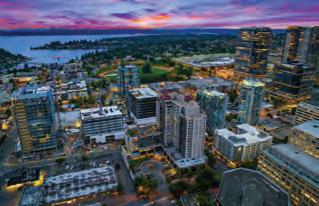




Courtesy American Lung Association

The American Lung Association in Washington recently announced that John Aitchison of Seattle Children’s Hospital was awarded the Lung Association’s coveted COVID-19 Respiratory Virus Research Award.


Aitchison’s project aims to further research on the use of inhaled nanobodies to complement current COVID-19 vaccines and drugs to serve critically ill patients, act as a preventative treatment, and retain effectiveness against new variants of the virus.
“Here in Washington, we face continued lung health challenges from COVID-19 every day,” Season Oltmann, executive director of the American Lung Association in Washington, said. “This is in addition to our region’s lung health being threatened by poor air quality due to increased wildfire smoke, continued cigarette and e-cigarette use and more. Today, more than 917,000 people in our state are living with chronic lung disease.
“We are excited for John Aitchison to join the American Lung Association Research Team to help improve lung health here in Washington and across the nation.”
In the 2022-23 grants cycle, the Lung Association is funding $13.2 million for more than 130 lung health research grants. For this round of funding, the organization placed a greater focus on strategic partnerships with key organizations like American Thoracic Society and CHEST, along with grants that focus on equity, such as the Harold Amos Scholar.
Research projects funded by the Lung Association are carefully selected through scientific review and awardees represent the investigation of a wide range of complex issues. Awards were given in eight different categories: ALA/ AAAAI Allergic Respiratory Diseases Award; ALA/ATS/ CHEST Foundation Respiratory Health Equity Research Award; Catalyst Award; COVID-19 Respiratory Virus Research Award; Dalsemer Award; Innovation Award; Lung Cancer Discovery Award; and Public Policy Research Award.
For more information about the new grant awardees and the entire American Lung Association Research Team, visit Lung.org/research-team.
Seattle Art Museum’s upcoming show explores Black experience through photos
The Seattle Art Museum presents Dawoud Bey & Carrie Mae Weems: In Dialogue from Nov. 17 to Jan. 22, 2023. The show features over 140 works by two of the most significant photo-based artists working today, according to a press release.
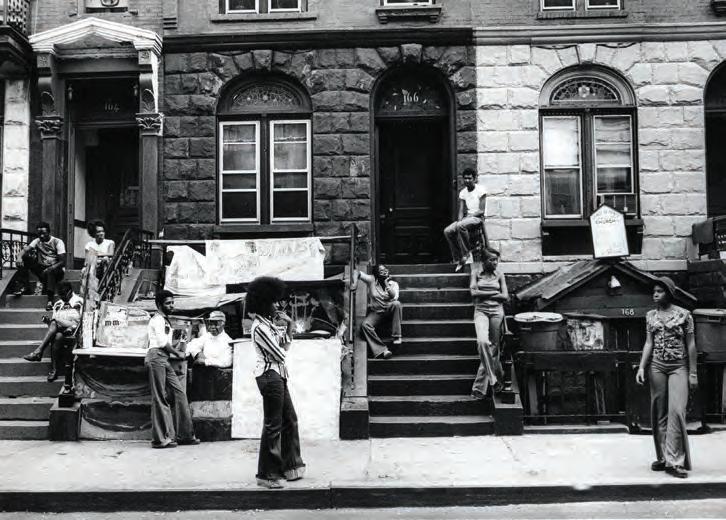
Both born in 1953, Bey and Weems explore ideas grounded in the experiences of Black people refracted through issues of gender, class and systems of power.
In Dialogue presents a series of thematic explorations of their distinct yet overlapping concerns and approaches.
This is the first time their celebrated work — the subject of numerous solo and group exhibitions — has been shown together to explore their spirited engagement with each other over the years.
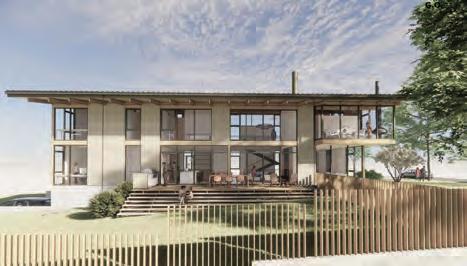
SAM is the third stop on the exhibition’s United States tour, which was organized by the Grand Rapids Art Museum and curated by Ron Platt. SAM’s iteration is curated by Catharina Manchanda, Jon and Mary Shirley curator of
Modern and Contemporary Art.
“The work of these two artists has never been more relevant, combining a tender embrace and celebration of Black people with a clear-eyed awareness of the power imbalances to which they have been subjected since the days of slavery,” Manchanda said in a press release. “We are excited to invite everyone
into their career-long conversations about art, culture and history.”
In conjunction with the exhibition, the museum will present other programs and engagement opportunities. A free community opening take place Dec. 1 during First Thursday when the museum is free to all, all day. And social media initiative #SAMPhotoClub invites people to
share photographs based on themes inspired by the exhibition for the opportunity to be highlighted on SAM digital channels.
SAM is open from 10 a.m. to 5 p.m. Wednesday through Sunday, 1300 First Ave. S., Seattle. For the most up-to-date information on SAM events or ticket prices, go to seattleartmuseum.org.
Chris Sudore
“As a Madison Park Resident, I care about your home‘s value.”






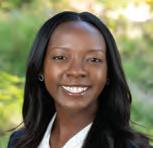
7 NOVEMBER 2022 Pacific Publishing Company – Queen Anne & Magnolia News • Madison Park Times
Curious what your home is worth in today‘s market? Contact us today for a free market evaluation
Ryder Fasse Sales Broker Nikki Betz Sales Broker Memoree Myers Office Manager
Chris Sudore |
Broker Madison Park Your Specialist In: Madison Park • Washington Park • Broadmoor Denny Blaine • Capitol Hill • Madrona • Leschi Chris@KingCountyEstates.com 206-799-2244 KingCountyEstates.com Coldwell Banker‘s Global Luxury Team | King County Estates Active | 803WashingtonPark.com | $3,498,000 Active Active Sold Sold Sold Sold
Managing
Chris
Sudore President/Founder
Megan Bassetti Marketing
Stephanie Brown Sales Broker
Courtesy Seattle Art Museum
Harlem Street, 1976–77, Carrie MaeWeems, American, born 1953, gelatinsilver print, 5 5/16 x 8 15/16 inches,
©Carrie Mae Weems, courtesy of the artist and Jack Shainman Gallery, NewYork.





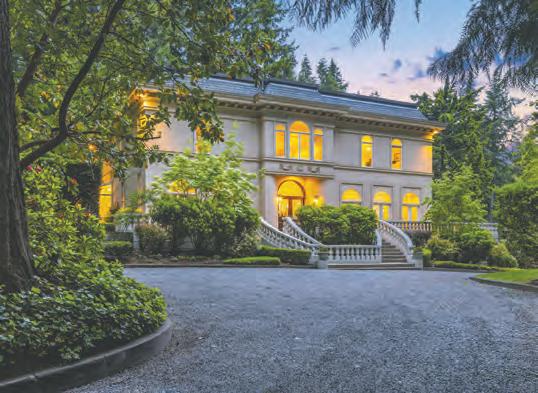



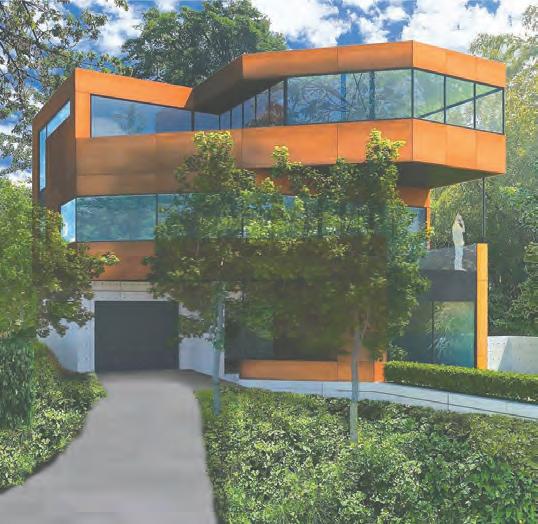


8 NOVEMBER 2022

















 By Ned Porges Guest columnist
By Ned Porges Guest columnist






















































































